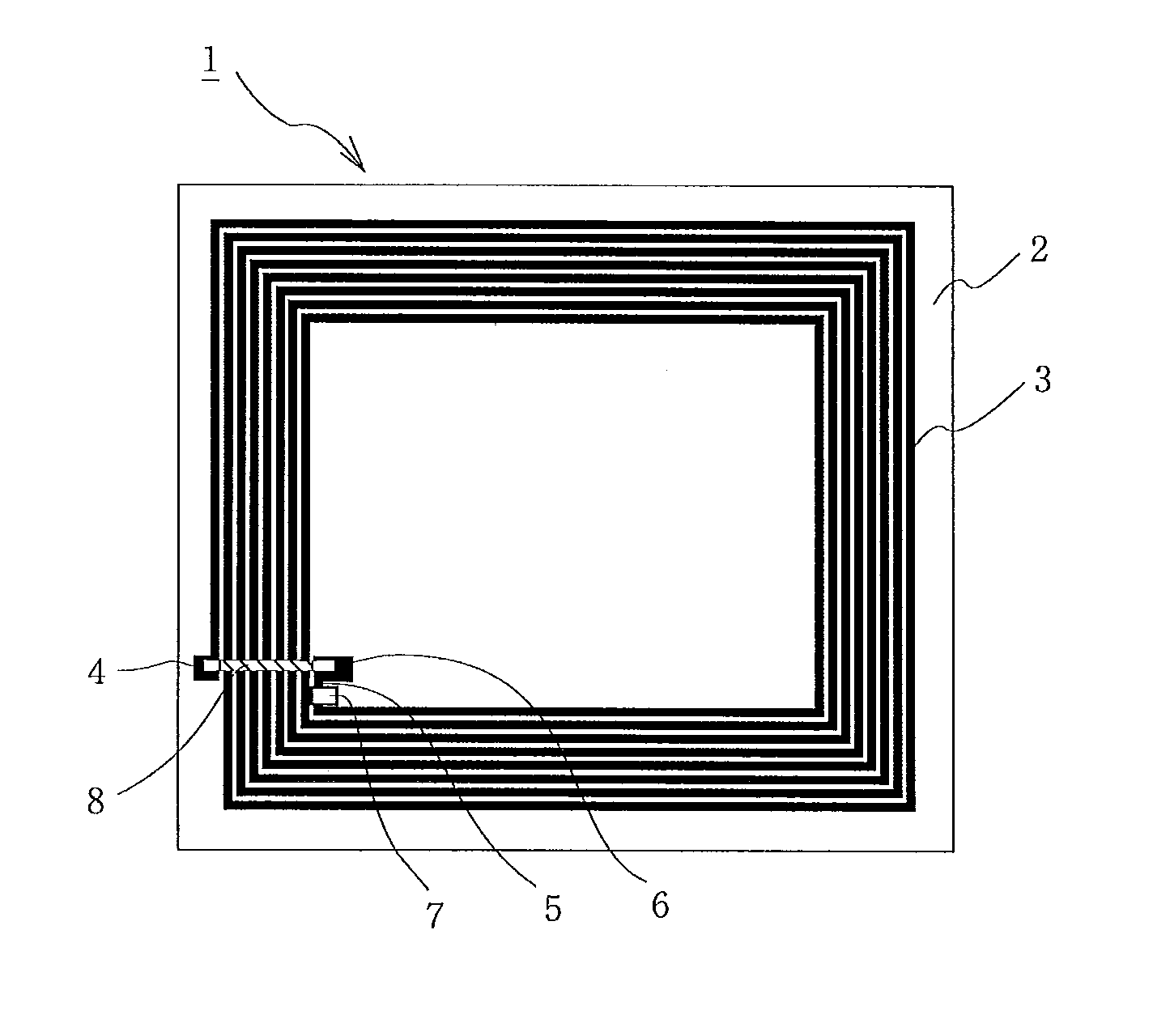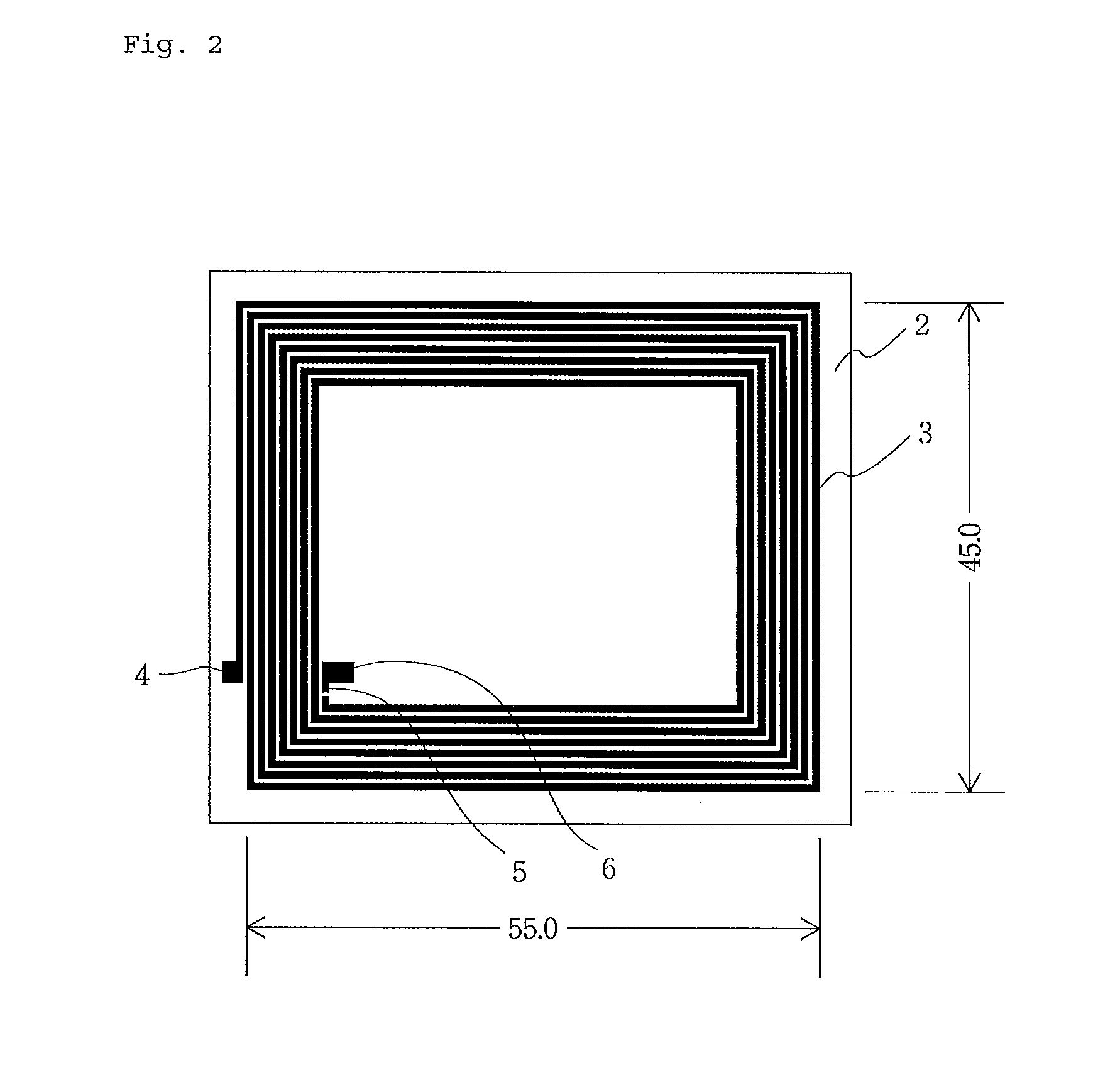Wireless IC tag and method for manufacturing wireless IC tag
a technology of wireless ic tags and wires, applied in the field of wireless ic tags, can solve the problems of consuming more power, affecting the reduction of material cost, and high cost of metals such as copper or silver, and achieves the effects of easy adjustment of length, excellent communication characteristics, and simple structur
- Summary
- Abstract
- Description
- Claims
- Application Information
AI Technical Summary
Benefits of technology
Problems solved by technology
Method used
Image
Examples
first embodiment
Structure of IC Tag
[0143]This embodiment will be described hereunder, based on the drawings. FIG. 1 is a schematic view showing an IC tag according to this embodiment.
[0144]In FIG. 1, the reference numeral 1 designates an IC tag, and 2 a substrate (glassine paper manufactured by Lintec Corporation). Antenna circuits are denoted by 3 to 6, among which 4 and 6 designate the respective end portions of the antenna circuits. The numeral 7 designates an IC chip (I-CODE SLI manufactured by Philips Electronics N.V.), and two electrodes of the IC chip 7 (not shown) are each connected via the antenna circuit 3 and 5 respectively. The end portions 4 and 6 of the antenna circuit are connected via a jumper wire 8 (diameter 0.05 mm, coated with polyurethane in a thickness not less than 5 μm, manufactured by Riken Electric Wire Co., Ltd.).
[0145]The surface of the IC tag shown in FIG. 1 is finally laminated with a PET film (commercially available article, now shown) with a commercially available la...
second embodiment
Structure of IC Tag
[0166]According to the same procedures as in the first embodiment, except that a glassine paper (glassine W87.5 kg) was utilized as the substrate and one on the two patterns described in FIG. 4 was utilized as the pattern of the antenna circuit, the IC tag was made, and then subjected to a performance check.
[0167][Result of Performance Check]
[0168]The result of the performance check of the IC tag according to the second embodiment was as follows.[0169](i) impedance: 12 to 17Ω[0170](ii) resonant frequency (before laminating): 13.80 to 13.90 MHz[0171]resonant frequency (after laminating): 13.40 to 13.60 MHz[0172](iii) communication range (after laminating, aerial): 40 to 45 mm
third embodiment
[0173]According to the same procedures as in the first embodiment, except that a pattern described in FIG. 5 was utilized as the pattern of the antenna circuit, the IC tag was made, and then subjected to a performance check.
[0174][Result of Performance Check]
[0175]The result of the performance check of the IC tag according to the third embodiment was as follows.[0176](i) impedance: 14 to 16[0177](ii) resonant frequency (before laminating): 14.50 to 14.60 MHz[0178]resonant frequency (after laminating): 14.10 to 14.30 MHz[0179](iii) communication range (after laminating, aerial): 35 to 40 mm
[0180]In view of the performance check result, it has been confirmed that in the IC tag according to the first to third embodiments, the antenna circuit was adequately formed, the IC chip and the antenna circuit were adequately connected, sufficiently small impedance was achieved, and a good characteristic was attained in communication range. It has also been confirmed that the IC chip was firmly f...
PUM
| Property | Measurement | Unit |
|---|---|---|
| temperature | aaaaa | aaaaa |
| thickness | aaaaa | aaaaa |
| thickness | aaaaa | aaaaa |
Abstract
Description
Claims
Application Information
 Login to View More
Login to View More - R&D
- Intellectual Property
- Life Sciences
- Materials
- Tech Scout
- Unparalleled Data Quality
- Higher Quality Content
- 60% Fewer Hallucinations
Browse by: Latest US Patents, China's latest patents, Technical Efficacy Thesaurus, Application Domain, Technology Topic, Popular Technical Reports.
© 2025 PatSnap. All rights reserved.Legal|Privacy policy|Modern Slavery Act Transparency Statement|Sitemap|About US| Contact US: help@patsnap.com



